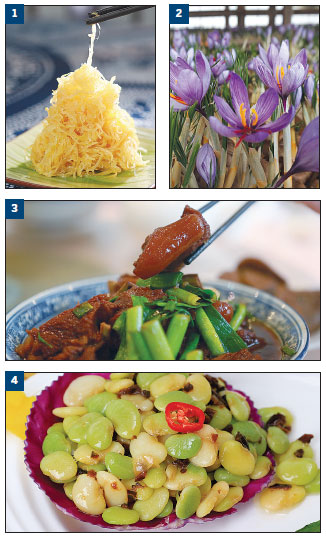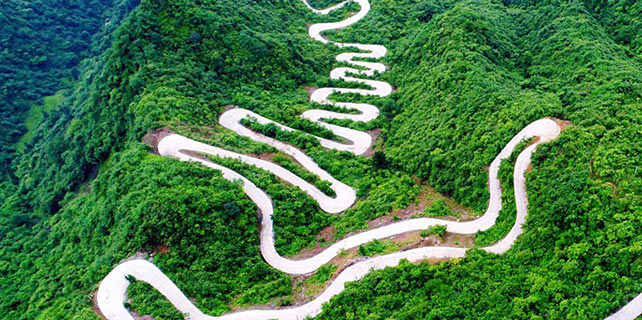A taste of a unique island, in four bites
Chongming is the world's largest sand island, and with its location on the estuary of the Yangtze River and the East China Sea and its unique soil traits, it is endowed with ideal conditions for growing many plants, vegetables and fruits.
Between 2010 and 2015, the local government shut down 156 factories and plants considered environmentally unfriendly, at a loss of 1.73 billion yuan ($260 million), to turn the 1,267-square-kilometer island into both an urban retreat for people and a paradise for flora and fauna. Last year its agriculture generated 5.9 billion yuan in revenue, accounting for one-third of the agricultural products consumed by the 24 million people of Shanghai. In addition to the produce the island grows, it has attracted an increasing number of urbanites fleeing city life to become farmers.
Following are some of the most well-known agricultural products from the island that distinguish it from other places and have proven to be irresistible to millions of Shanghainese, so much so that they are willing to make the return journey of 150 kilometers for a taste of Chongming.
1. Golden melon
Chongming is believed to have grown golden melons since the Ming Dynasty (1368-1644), after Chinese ships made their largest and longest overseas voyage in ancient history, with 240 vessels and 27,000 crew sailing to more than 30 countries and regions. They brought back a variety of foreign produce in exchange for china. But after centuries of cross-breeding, the melons grown in Chongming today are eight times larger than the original ones and weigh as much as a watermelon, says Chen Jun, vice-director of the district's agriculture department.
The melon is dubbed the vegetable jellyfish, mainly because of the similar color after it is peeled and sliced as an autumn appetizer, and its texture and flavor are closer to those of cucumbers.
Each year Chongming grows 530 hectares of golden melons, which weigh 24,000 metric tons. Since 1985 the island's golden melons have been exported to a dozen countries, and this autumn, for the first time, 500 kg of fresh golden melons are going to be sold in Hong Kong.
2. Saffron
The Chinese word for saffron is zanghonghua, which means Tibetan red flower, and with a strong misconception in mind many tourists in Tibet have sought it out as a souvenir. Chongming is the largest producer of the flower in China, accounting for more than 90 percent of the output.
Gu Jianpei, a veteran saffron grower and trader in Chongming, said the island started to plant the flower early in the 1980s, after a biologist consulting for Shanghai Medicine Group discovered that the sand-soil in Chongming is ideal for the flower, which is widely used in traditional Chinese medicine.
Saffron, native to the Mediterranean, has stringent environmental needs to grow successfully, unable to survive below -7 C or above 30 C, or with any chemicals or chemically polluted soil.
In 2015, the island produced a record 800 kg of saffron. The flower's high profitability - it takes about six months from sowing to harvesting - has also attracted an increasing number of local farmers to cultivate it.
3. White goat
Just as many Parisians travel to Normandy every oyster season for oysters, Shanghainese used to ferry for hours to Chongming during winter, before the Yangtze River tunnel and bridge opened in 2009, for a taste of the meat that the Chongming white goat yields. The goat, a protected species listed by the national agricultural department as the most important goat breed in the Yangtze River Delta region, is celebrated for its smaller size, tender meat, and free of the gamey odor common to many goats.
It is usually served after being boiled in water, with a dish of soy sauce. While the goat is available all year around, the tradition to savor it mostly in winter is believed to result from the saying that "One more dish of white goat on the table, one less cotton-padded jacket in the wardrobe", as in traditional Chinese medicines, goat is considered to generate and preserve human body heat.
However, the white goat's smallness, mainly because of its slower growth, is endangering the species as farmers are desperate to accelerate its growth by cross-breeding it with other goat types. Since 2007 the Shanghai Academy of Agriculture Science has had a special project to preserve the purity of the Chongming white goat. It has saved 300 embryos and 500 frozen sperm, which a researcher with the academy, Lin Yuexia, said are believed to be able to stay active for about 100 years.
4. White haricot
Together with old white wine (sticky rice wine) and white goat, natives of Chongming island treasure white haricot as one of "three whites".
Brought to China from India by Western missionaries more than a century ago, the locals of Chongming have nicknamed it baibiandou, or foreign beans. With a size and texture that are similar to those of English beans, it is usually lightly fried with a spray of spring onions as a vegetable dish and enjoyed from late summer to early winter by island residents.













